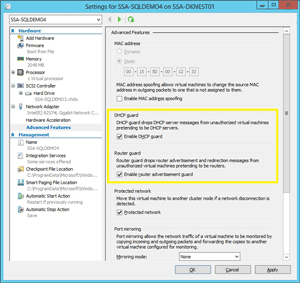7 Hot Hyper-V Tips
One of the things I love nowadays is doing little things that make a difference. That was the spirit of my recent post on 7 random tips for vSphere. I thought now it'd be a good time to do the same for Hyper-V. As before, this is a list of random tips to help make day-to-day Hyper-V tasks easier.
1. Wouldn't it be nice to know the IP address of a Hyper-V virtual machine (VM) without logging into it or going to the networking tab in Hyper-V Manager? You can with PowerShell. A simple PowerShell script makes this easy; see this MSDN blog for details. This is a great way to get a list of every VM you have, including its name and IP address.
2. Don't forget Hyper-V's built-in router guard and DHCP guard, which prevent unauthorized guest networking. This is a great one to set in VM libraries or PowerShell. The Set-VMNetworkAdapter cmdlet will allow you to set these powerful options as well, as shown in Figure 1.
 [Click on image for larger view.]
Figure 1. Hyper-V's Router guard and DHCP guard can boost your network's security.
[Click on image for larger view.]
Figure 1. Hyper-V's Router guard and DHCP guard can boost your network's security.
3. Another PowerShell tip: A very good cmdlet to get some quick resource utilization on Hyper-V VMs is the Measure-VM command. Major resource utilization is reported here, and it's a good way to take a look at the VM's usage. Make sure you also enable resource metering on the VM.
4. If you have a Hyper-V cluster, you should be using the Cluster Validation Wizard. Remember to run the validation wizard occasionally after the cluster has been deployed, following tasks like:
- Critical updates
- Adding servers to, or removing servers from, a cluster
- Adding new storage arrays or shared volumes
- Other key tasks
5. Windows Server 2016 includes nested virtualization; keep that in mind with your upgrade cycles. I'm personally super excited about nested Hyper-V, and am also very curious how it will impact Azure. I was a bit early with my news of this feature in July; but now things are a lot clearer.
6. Related to the new technologies coming from Microsoft, keep in mind that Nano Server is coming. Nano Server is an extremely small footprint operating system that provides four key roles: Hyper-V (yay!); failover clustering; file server; and other storage roles and forwarders for reverse application compatibility (e.g., Ruby, Node.js and so on). My colleague Clint Wyckoff did a vBrownBag Tech Talk on this topic; check out this video.
7. If you're getting serious about Hyper-V, it may be time to
look at the Azure stack. You can run Azure-style services in your own datacenter. This is a significant endeavor, but it's got everything most environments need in an easy-to-consume model.
Posted by Rick Vanover on 11/20/2015 at 1:46 PM